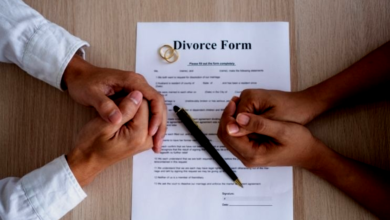How to File for Divorce in California Without a Lawyer
How to File for Divorce in California Without a Lawyer Learn the step-by-step process for filing an uncontested divorce pro se in California including required forms and procedures Save on legal fees with this complete guide.

Filing for divorce in California without a lawyer is a common choice for couples who have an amicable separation and want to avoid costly legal fees. Known as a pro per or pro se divorce, this process allows individuals to handle their own case by following Divorce in California legal requirements. While it demands careful attention to paperwork and court procedures, many people successfully complete their divorce without an attorney especially in uncontested cases where both spouses agree on key issues like property division, child custody, and support. This guide will walk you through each step, from eligibility checks to finalizing your divorce, ensuring you meet all legal standards while representing yourself.
Before beginning, it’s important to understand that California is a no-fault divorce state, meaning you don’t need to prove wrongdoing only that there are “irreconcilable differences.” The process involves filing the correct forms, serving your spouse, and adhering to a mandatory six-month waiting period. While hiring a lawyer can be helpful in complex situations, many Californians find that with proper research and preparation, they can navigate the divorce process independently. Below, we’ll outline everything you need to know to file for divorce in California without a lawyer, ensuring a smooth and legally valid outcome.
How to File for Divorce in California Without a Lawyer
Residency Requirements for Filing Divorce in California
To file for divorce in California, you or your spouse must meet strict residency rules. At least one party must have been a California resident for a minimum of six months before filing. Additionally, you must have lived in the county where you plan to file for at least three months immediately before submitting your divorce petition. These requirements ensure the Divorce in California courts have proper jurisdiction over your case. If you recently moved to California, you’ll need to wait until you meet both the state and county residency timelines before initiating divorce proceedings. The court will verify your residency through documents like driver’s licenses, voter registration, or utility bills if questioned.
No-Fault Divorce and Mandatory Waiting Period
California operates exclusively as a no-fault divorce state, meaning you cannot cite reasons like adultery or abandonment as grounds for divorce. The only acceptable legal reason is “irreconcilable differences,” which essentially means the marriage cannot be saved. Once you file and serve your spouse, California law imposes a mandatory six-month waiting Divorce in California before your divorce can be finalized. This cooling-off period begins the date your spouse is officially served with divorce papers (not the filing date). Even if you reach immediate agreement on all issues, the court cannot grant a final divorce judgment until this waiting period elapses.
Preparing the Necessary Divorce Forms
Essential Forms to Initiate the Divorce Process
The foundation of your divorce filing begins with three critical forms Petition (FL-100): This is the primary document that officially starts your divorce case, containing basic information about your marriage, residency, and the relief you’re requesting from the court. Summons (FL-110): A legally required notice that informs your spouse about the divorce proceedings and outlines important restrictions (like not changing insurance policies or removing children from the state). Child Custody Form (FL-105): Mandatory if you have minor children, this establishes which court has jurisdiction over custody matters. These forms must be filed together at your local Superior Court to begin your Divorce in California.
Additional Required Forms for Financial and Child-Related Matters
Depending on your situation, you may need to prepare supplementary documentation Financial Disclosures (FL-140/FL-150): California requires full financial transparency. The Declaration of Disclosure lists all assets/debts, while the Income and Expense Declaration details monthly earnings and spending – crucial for determining support obligations. Optional but Recommended Marital Settlement Agreement (FL-130) if you’ve reached mutual agreements. Child Support Information (FL-191) if support is involved. All forms are available for free through California’s Judicial Council website (courts.ca.gov). Many courts also offer workshops or clinics to help with form completion. Remember that incomplete or inaccurate forms are the most common reason for processing delays.
Filing the Divorce Papers with the Court
Filing Procedures and Fee Waiver Options
To officially begin your divorce case, you must file your completed forms with the Superior Court in your county of residence. The current filing fee is $435 (subject to change), payable by cash, money order, or in some counties, credit/debit Divorce in California. If you meet low-income requirements, you can request a Fee Waiver (FW-001) which, if approved, eliminates all filing costs. When submitting your paperwork, The court clerk will stamp all documents with a case number. You’ll receive a filed copy of each form for your records. Some counties now allow e-filing for faster processing.
Legal Service Requirements and Alternatives
California law mandates strict rules for serving divorce papers Who Can Serve Any non-party adult (18+) or professional process server. Service Methods Personal delivery (most common), mail with acknowledgment (FL-117), or publication (last resort if spouse can’t be located). Proof of Service Must file either Proof of Service of Summons (FL-115) for personal service. Divorce in California of Receipt (FL-117) if spouse voluntarily accepts papers. Deadlines Respondent must be served within 60 days of filing (extendable). Special Cases Different rules apply for protected persons (restraining orders) or out-of-state service
Negotiating Terms and Finalizing the Divorce
If your spouse responds, you may need to negotiate terms regarding property division, spousal support, child custody, and visitation. Divorce in California follows community property laws, meaning marital assets and debts are generally split equally. However, couples can agree to alternative arrangements, which should be documented in a Marital Settlement Agreement (FL-130).
Read More: Dealing With Medical Debt in North Carolina When to Contact a Bankruptcy Attorney
Conclusion
Successfully filing for divorce in California without a lawyer is an achievable goal for couples who are willing to put in the time and effort to understand the legal process. By carefully completing the required forms, following proper filing procedures, and meeting all court deadlines, you can navigate an uncontested divorce efficiently. While the process may seem daunting at first, California’s self-help resources, including court-provided forms and online guides, make it possible to handle your divorce independently when both parties are cooperative.
However, it’s important to recognize when professional legal advice might be necessary, particularly in cases involving complex assets, disputes over child custody, or an uncooperative spouse. While filing without a lawyer can save money, some situations may require expert guidance to protect your rights and interests. Ultimately, with patience and attention to detail, many Californians find they can complete their divorce without attorney representation, moving forward to the next chapter of their lives with confidence and clarity.
FAQs
Can I file for divorce in California without a lawyer?
Yes, you can file for divorce without a lawyer if your case is uncontested and you follow the correct legal procedures.
How long does it take to finalize a divorce in California?
The minimum waiting period is six months from the date the respondent is served, but the process may take longer if disputes arise.
What are the residency requirements for a California divorce?
At least one spouse must live in California for six months and in the filing county for three months before filing.
How much does it cost to file for divorce in California?
The filing fee is approximately $435, but fee waivers are available for those who qualify based on income.
What if my spouse doesn’t agree to the divorce?
California is a no-fault state, so one spouse can still obtain a divorce even if the other disagrees, but contested cases may require court hearings.











